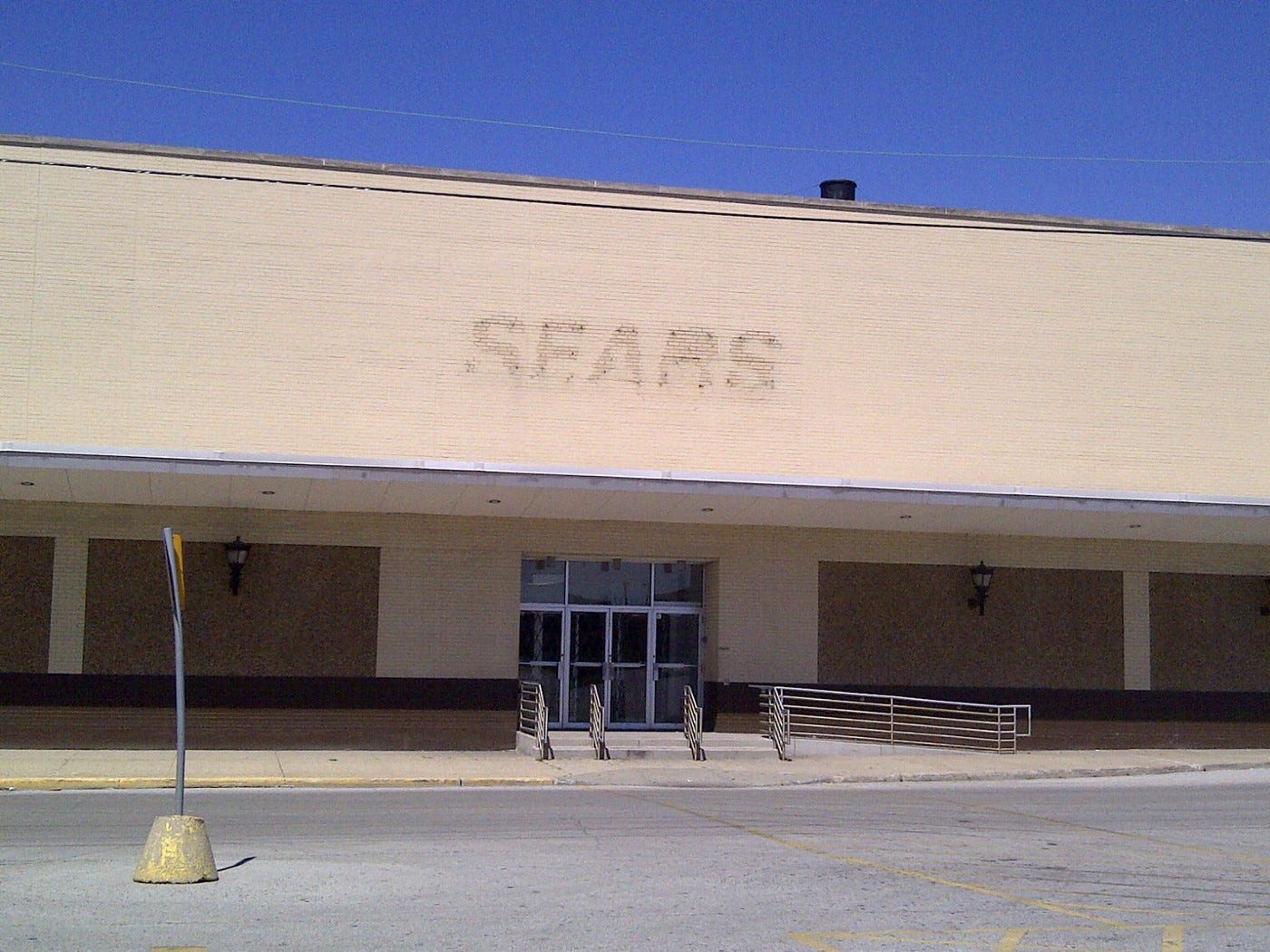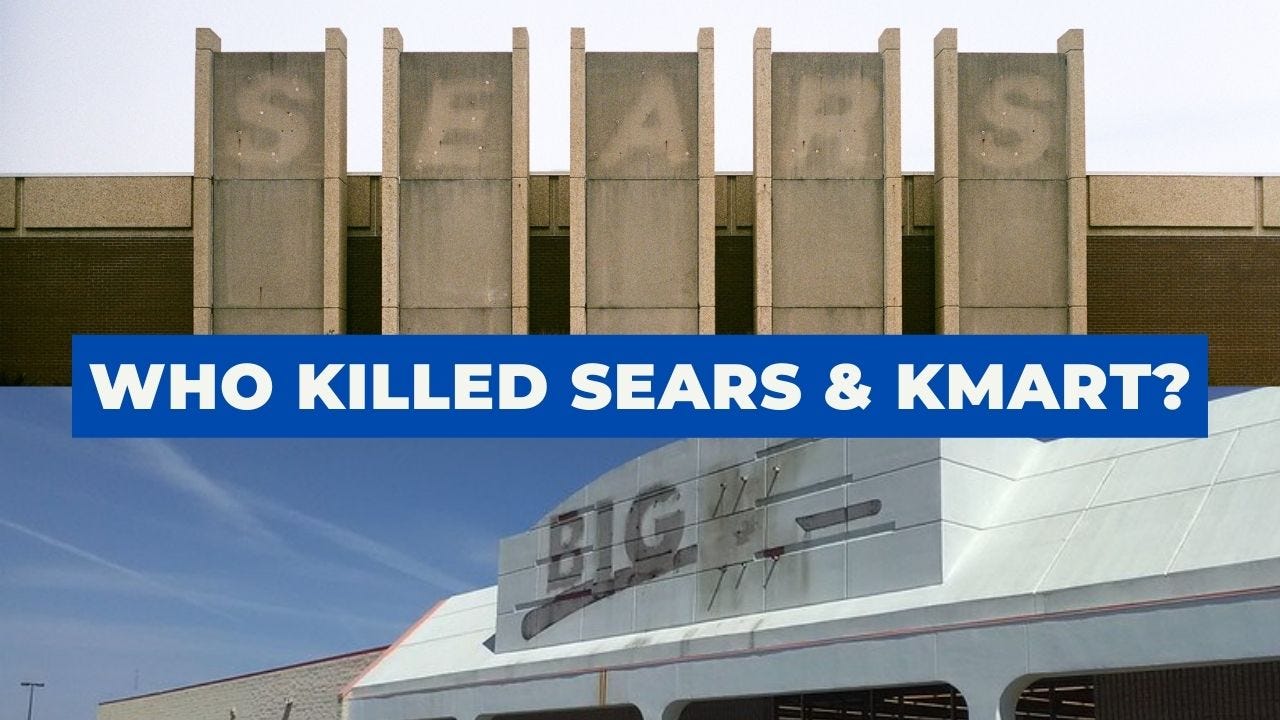
Editor’s note: The following is an article from October 2021. Please consider subscribing to Church and Main. Also, please share this series with people you know.
In a few weeks' time, the last Kmart and the last Sears will close in the United States. Most people won’t notice let alone care. The real Sears story has never garnered much interest. Most people especially the media have bought into a certain narrative: that Sears and Kmart failed to keep up with the times and now they are paying the consequences. One of the responses to my recent article about Sears wondered if this is about “creative destruction.” So, is Sears basically the victim of the natural churn of capitalism or is it about something more sinister?
First, you have to define what the phrase “creative destruction” means. The term was made famous by Austrian political economist Joseph Schumpeter. Creative destruction describes how capitalism leads to constant change in the economy. The website economicshelp.org says that old businesses and industries “which are no longer profitable, close down enabling the resources (capital and labor) to move into more productive processes.”
So if say, a car company is losing money left and right, it’s not beneficial for the economy. The car company should cease business which would free up capital like factories and labor that can now be used in more profitable businesses.
It should be noted that Schumpeter borrowed and re-interpreted the phrase. Its original creation came from Karl Marx in describing how capitalism will destroy itself. Schumpeter believed that this churning would lead to capitalism’s renewal as old businesses passed and new businesses sprung up.
So, was Sears the result of creative destruction? Maybe. By the turn of the century, Sears and Kmart were looking tired. They were not the leaders they once were. It could be argued that over time, the two chains would be incredibly unprofitable and could end up being liquidated years down the road. This is the dynamism of the free market.
But was what happened to Sears part of creative destruction? Retail journalist Warren Shoulberg is blunt in saying what was former CEO and current owner Eddie Lampert's strategy for Sears and Kmart: “His strategy from the very beginning was to pull cash out of that business. It was not to run the businesses. If it had been to run the businesses, we would have seen very different activities,” he said in a recent interview. “They kept selling real estate and it wasn’t just real estate. They sold brand names. They stopped investing in their stores. I don’t have the numbers in front of me, but you look at Sears and Kmart capital expenditure budget versus a target, and it was a fraction of it.”
One could argue that Sears didn’t die a normal death, but was instead killed slowly. The destruction seemed methodical instead of capitalism doing its thing.
For some reason, Sears is doing great in Mexico. Carlos Slim, one of the world’s richest men, owns the chain and has made it very competitive in the Mexican market. Eddie Lampert didn’t do that.
Lampert heads a hedge fund and like its cousin private equity, the goal of a business owned by a hedge fund is to take money out of the business instead of trying to generate wealth. That seems to go against creative destruction because capital and labor aren’t opened up for new businesses. Workers are let go. Real estate is sold, but in many cases, the real estate sits empty.
Lampert isn’t getting rich by making sure sales are up. He’s making money by bleeding Sears dry.
What happened to Sears is not unlike what is going on among newspapers. Read McKay Coppins depressing read in the Atlantic about how Alden Global Capital, a hedge fund is buying up newspapers and gutting staff in order to squeeze profits from the papers. The end result is smaller staffs that are now missing important scandals, crime, and other stories.
What’s happening in our economy is that getting value from capital or asset valuation is separated from growth, as Julius Krein explains in his latest article for American Affairs. “Today’s shareholder-driven corporations are not necessarily — or even primarily — motivated to engage in the traditional methods of ‘growing a business,’” he says. “Companies are often highly incentivized to pursue financial engineering and valuation multiple expansion, rather than investing to increase earnings. Eliminating profit streams can actually increase shareholder returns when the remaining company trades at a higher valuation — especially if share buybacks or other cash returns feature in the process.”
Creative destruction also became an excuse. Save for a journalist here and there, most of the media really ignored what was going on. Everyone bought into the narrative that Sears didn’t keep up with the times. That’s partially true, but it’s not the main story. Maybe people wanted to believe the narrative of Amazon killing Sears or maybe trying to talk about real estate and hedge funds was too complex for some journalists to turn into a compelling story. Or, maybe because newspapers are being squeezed by the same people killing Sears that there was no one around to cover the story.
So what happens at Sears might well be creative destruction, but not all creative destruction is beneficial to the market and society.
I’ve said this before, but I will say it again: I believe capitalism can be a force for good, but being a good neo-orthodox Protestant Christian, I believe our world is fallen which means that everything in our world is imperfect and falls short.
We need to find ways to make sure capitalism benefits everyone and right now it isn’t. In order to save capitalism, we need to make sure government can make sure that business is working to better society and not just shareholders.
It might sound like I’m some sort of socialist that is complaining about late-stage capitalism. But I’m right of center and believe in the free market. But when people like Lampert run around destroying companies and getting away with it, it gives capitalism a bad name. If we want a strong market, we have to make sure it is a fair market.
At some point, the last Sears or Kmart will close. These two names will disappear from the scene. Consumers will be left with less choice. Thousands losing their jobs. Eddie Lampert will walk away losing nothing while the larger public will just shrug their shoulders, distracted by the trivia of the day.
It didn’t have to end this way. But it will end this way, again and again to all sorts of businesses, from retail to newspapers to manufacturing. It will be called creative destruction, but these companies didn’t die because someone was better. They died because of sloth, pride, and of course, greed.
It didn’t have to end this way.
Who Killed Sears and Kmart? Series":





Kmart in Australia was having the same problems as Kmart in America. This was not long after Kmart America had sold their interest in Kmart Australia. A new owner came in, refurbished the stores, added smaller stores, and focused on being customer service based, and are now thriving in Australia. America could have seen a different outcome if another CEO had taken over during their first bankruptcy, because yes, they likely don't surpass Walmart, but Target is proving there is room for multiple discount stores, and are doing many of the same things Australia Kmart is doing- focusing on customers, revitalizing their stores, opening smaller stores in urban areas, things Kmart should have done 20 years ago, but didn't.